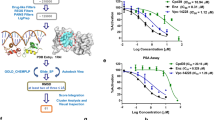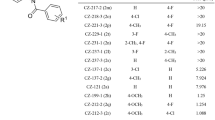Abstract
As a major class of medicine for treating the lethal type of castration-resistant prostate cancer (PCa), long-term use of androgen receptor (AR) antagonists commonly leads to antiandrogen resistance. When AR signaling pathway is blocked by AR-targeted therapy, glucocorticoid receptor (GR) could compensate for AR function especially at the late stage of PCa. AR-GR dual antagonist is expected to be a good solution for this situation. Nevertheless, no effective non-steroidal AR-GR dual antagonist has been reported so far. In this study, an AR-GR dual binder H18 was first discovered by combining structure-based virtual screening and biological evaluation. Then with the aid of computationally guided design, the AR-GR dual antagonist HD57 was finally identified with antagonistic activity towards both AR (IC50 = 0.394 μM) and GR (IC50 = 17.81 μM). Moreover, HD57 could effectively antagonize various clinically relevant AR mutants. Further molecular dynamics simulation provided more atomic insights into the mode of action of HD57. Our research presents an efficient and rational strategy for discovering novel AR-GR dual antagonists, and the new scaffold provides important clues for the development of novel therapeutics for castration-resistant PCa.
This is a preview of subscription content, access via your institution
Access options
Subscribe to this journal
Receive 12 print issues and online access
$259.00 per year
only $21.58 per issue
Buy this article
- Purchase on Springer Link
- Instant access to full article PDF
Prices may be subject to local taxes which are calculated during checkout








Similar content being viewed by others
References
Siegel RL, Miller KD, Fuchs HE, Jemal A. Cancer statistics, 2021. Ca-Cancer J Clin. 2021;71:7–33.
Huggins C, Stevens RE, Hodges CV. Studies on prostate cancer II. The effects of castration on advanced carcinoma of the prostate gland. Arch Surg. 1941;43:209–23.
Kumar R. Emerging role of glucocorticoid receptor in castration resistant prostate cancer: a potential therapeutic target. J Cancer. 2020;11:696–701.
Suh JH, Chattopadhyay A, Sieglaff DH, Storer Samaniego C, Cox MB, Webb P. Similarities and distinctions in actions of surface-directed and classic androgen receptor antagonists. PLoS One. 2015;10:e0137103.
Waltering KK, Urbanucci A, Visakorpi T. Androgen receptor (AR) aberrations in castration-resistant prostate cancer. Mol Cell Endocrinol. 2012;360:38–43.
Schmidt KT, Huitema ADR, Chau CH, Figg WD. Resistance to second-generation androgen receptor antagonists in prostate cancer. Nat Rev Urol. 2021;18:209–26.
Rice MA, Malhotra SV, Stoyanova T. Second-generation antiandrogens: from discovery to standard of care in castration resistant prostate cancer. Front Oncol. 2019;9:801.
Veldscholte J, Ris-Stalpers C, Kuiper GG, Jenster G, Berrevoets C, Claassen E, et al. A mutation in the ligand binding domain of the androgen receptor of human LNCaP cells affects steroid binding characteristics and response to anti-androgens. Biochem Biophys Res Commun. 1990;173:534–40.
Xie N, Cheng H, Lin D, Liu L, Yang O, Jia L, et al. The expression of glucocorticoid receptor is negatively regulated by active androgen receptor signaling in prostate tumors. Int J Cancer. 2015;136:E27–38.
Arora VK, Schenkein E, Murali R, Subudhi SK, Wongvipat J, Balbas MD, et al. Glucocorticoid receptor confers resistance to antiandrogens by bypassing androgen receptor blockade. Cell. 2013;155:1309–22.
Isikbay M, Otto K, Kregel S, Kach J, Cai Y, Vander Griend DJ, et al. Glucocorticoid receptor activity contributes to resistance to androgen-targeted therapy in prostate cancer. Horm Cancer. 2014;5:72–89.
Mitani Y, Lin SH, Pytynia KB, Ferrarotto R, El-Naggar AK. Reciprocal and autonomous glucocorticoid and androgen receptor activation in salivary duct carcinoma. Clin Cancer Res. 2020;26:1175–84.
Yemelyanov A, Czwornog J, Gera L, Joshi S, Chatterton RT Jr., Budunova I. Novel steroid receptor phyto-modulator compound a inhibits growth and survival of prostate cancer cells. Cancer Res. 2008;68:4763–73.
De Bosscher K, Vanden Berghe W, Beck IM, Van Molle W, Hennuyer N, Hapgood J, et al. A fully dissociated compound of plant origin for inflammatory gene repression. Proc Natl Acad Sci USA. 2005;102:15827–32.
Wu M, Xie Y, Cui X, Huang C, Zhang R, He Y, et al. Rational drug design for androgen receptor and glucocorticoids receptor dual antagonist. Eur J Med Chem. 2019;166:232–42.
Rosette C, Agan FJ, Rosette N, Mazzetti A, Moro L, Gerloni M. The dual androgen receptor and glucocorticoid receptor antagonist CB-03-10 as potential treatment for tumors that have acquired GR-mediated resistance to AR blockade. Mol Cancer Ther. 2020;19:2256–66.
Schoch GA, D’Arcy B, Stihle M, Burger D, Bar D, Benz J, et al. Molecular switch in the glucocorticoid receptor: active and passive antagonist conformations. J Mol Biol. 2010;395:568–77.
Hu X, Pang J, Zhang J, Shen C, Chai X, Wang E, et al. Discovery of novel GR ligands toward druggable GR antagonist conformations identified by MD simulations and Markov state model analysis. Adv Sci. 2022;9:e2102435.
Case DC, Cheateham T, Darden T, Duke R, Giese T, Gohlke H, et al. AMBER 18. San Francisco: University of California; 2018.
Maier JA, Martinez C, Kasavajhala K, Wickstrom L, Hauser KE, Simmerling C. ff14SB: Improving the accuracy of protein side chain and backbone parameters from ff99SB. J Chem Theory Comput. 2015;11:3696–713.
Wang JM, Wolf RM, Caldwell JW, Kollman PA, Case DA. Development and testing of a general amber force field. J Comput Chem. 2004;25:1157–74.
Pang JP, Hu XP, Wang YX, Liao JN, Chai X, Wang XW, et al. Discovery of a novel nonsteroidal selective glucocorticoid receptor modulator by virtual screening and bioassays. Acta Pharmacol Sin. 2022;43:2429–38.
Gotz AW, Williamson MJ, Xu D, Poole D, Le Grand S, Walker RC. Routine microsecond molecular dynamics simulations with AMBER on GPUs. 1. Generalized born. J Chem Theory Comput. 2012;8:1542–55.
Lambrakos SG, Boris JP, Oran ES, Chandrasekhar I, Nagumo M. A modified shake algorithm for maintaining rigid bonds in molecular-dynamics simulations of large molecules. J Comput Phys. 1989;85:473–86.
Sun H, Duan L, Chen F, Liu H, Wang Z, Pan P, et al. Assessing the performance of MM/PBSA and MM/GBSA methods. 7. Entropy effects on the performance of end-point binding free energy calculation approaches. Phys Chem Chem Phys. 2018;20:14450–60.
Wang E, Weng G, Sun H, Du H, Zhu F, Chen F, et al. Assessing the performance of the MM/PBSA and MM/GBSA methods. 10. Impacts of enhanced sampling and variable dielectric model on protein-protein Interactions. Phys Chem Chem Phys. 2019;21:18958–69.
Wang EC, Sun HY, Wang JM, Wang Z, Liu H, Zhang JZH, et al. End-point binding free energy calculation with MM/PBSA and MM/GBSA: strategies and applications in drug design. Chem Rev. 2019;119:9478–508.
Hou T, Wang J, Li Y, Wang W. Assessing the performance of the molecular mechanics/Poisson Boltzmann surface area and molecular mechanics/generalized Born surface area methods. II. The accuracy of ranking poses generated from docking. J Comput Chem. 2011;32:866–77.
Onufriev A, Bashford D, Case DA. Exploring protein native states and large-scale conformational changes with a modified generalized born model. Proteins. 2004;55:383–94.
Zhou W, Duan M, Fu W, Pang J, Tang Q, Sun H, et al. Discovery of novel androgen receptor ligands by structure-based virtual screening and bioassays. Genom Proteom Bioinform. 2018;16:416–27.
Chai X, Sun H, Zhou W, Chen C, Shan L, Yang Y, et al. Discovery of N-(4-(Benzyloxy)-phenyl)-sulfonamide derivatives as novel antagonists of the human androgen receptor targeting the activation function 2. J Med Chem. 2022;65:2507–21.
Sun C, Shi Y, Xu LL, Nageswararao C, Davis LD, Segawa T, et al. Androgen receptor mutation (T877A) promotes prostate cancer cell growth and cell survival. Oncogene. 2006;25:3905–13.
Paul N, Carabet LA, Lallous N, Yamazaki T, Gleave ME, Rennie PS, et al. Cheminformatics modeling of adverse drug responses by clinically relevant mutants of human androgen receptor. J Chem Inform Model. 2016;56:2507–16.
Hara T, Miyazaki J, Araki H, Yamaoka M, Kanzaki N, Kusaka M, et al. Novel mutations of androgen receptor: a possible mechanism of bicalutamide withdrawal syndrome. Cancer Res. 2003;63:149–53.
Korpal M, Korn JM, Gao X, Rakiec DP, Ruddy DA, Doshi S, et al. An F876L mutation in androgen receptor confers genetic and phenotypic resistance to MDV3100 (enzalutamide). Cancer Discov. 2013;3:1030–43.
Joseph JD, Lu N, Qian J, Sensintaffar J, Shao G, Brigham D, et al. A clinically relevant androgen receptor mutation confers resistance to second-generation antiandrogens enzalutamide and ARN-509. Cancer Discov. 2013;3:1020–9.
Liu N, Zhou W, Guo Y, Wang J, Fu W, Sun H, et al. Molecular dynamics simulations revealed the regulation of ligands to the interactions between androgen receptor and its coactivator. J Chem Inform Model. 2018;58:1652–61.
Hu X, Chai X, Wang X, Duan M, Pang J, Fu W, et al. Advances in the computational development of androgen receptor antagonists. Drug Discov Today. 2020;25:1453–61.
Acknowledgements
This research was supported by National Key R&D Program of China (2019YFE0111300), National Natural Science Foundation of China (22220102001, 22273049), and Zhejiang Provincial Natural Science Foundation of China (LD22H300001).
Author information
Authors and Affiliations
Contributions
DL, TJH, and HGX initiated and supervised the research. XC and XH conducted virtual screening, compound validations and biological assays. XYW, HTW, JPP, JNL, LHS, XHX, and LX performed part of in vitro experiments and interpreted part of the data. WFZ performed part of in silico experiments. XC, XPH, TJH, and DL wrote the manuscript, and other authors contributed specific parts of the manuscript. HGX, TJH, and DL assume responsibility for the manuscript in its entirety. All authors have given approval to the final version of the manuscript.
Corresponding authors
Ethics declarations
Competing interests
The authors declare that they have no known competing financial interests or personal relationships that could have appeared to influence the work reported in this paper.
Supplementary information
Rights and permissions
Springer Nature or its licensor (e.g. a society or other partner) holds exclusive rights to this article under a publishing agreement with the author(s) or other rightsholder(s); author self-archiving of the accepted manuscript version of this article is solely governed by the terms of such publishing agreement and applicable law.
About this article
Cite this article
Chai, X., Hu, Xp., Wang, Xy. et al. Computationally guided discovery of novel non-steroidal AR-GR dual antagonists demonstrating potency against antiandrogen resistance. Acta Pharmacol Sin 44, 1500–1518 (2023). https://doi.org/10.1038/s41401-022-01038-7
Received:
Accepted:
Published:
Issue Date:
DOI: https://doi.org/10.1038/s41401-022-01038-7



